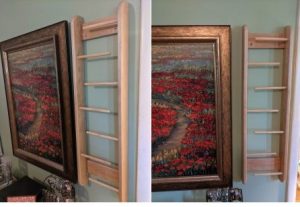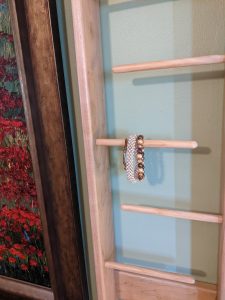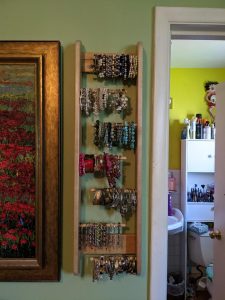The cats love to smack the bracelets off the dresser and onto the floor.
Endless fun for the cat, and constant picking up for the owner.
This simple bracelet holder, attached to the wall with a simple French cleat (only 2 screws) – is a clear winner for nicely showing off your bangles without tempting the felines to have an all out smackfest!
The Bracelet holder is made of solid 3/4″ Maple with 1/2″ wooden dowels drilled into the sides in an alternating pattern to allow easy insertion of the Bracelets and Bangles. It is approximately 11″ wide, 36″ in height, and 3- 1/4″ deep. It has a 3″ wood cleat at the bottom, and a 3″ French Cleat at the top.
The piece is finished with 3 coats of Varathane semi-gloss finish, brushed on. sanded with 320 paper in between coats. (links open to amazon product pages).


This project is a lot of fun, and required some accurate cutting on the table saw, rounding over the edges with a router, and a lot of fine sanding. The cleats were blind fastened with a Biscuit joiner, Glued with Gorilla Woodworking Glue, and clamped overnight. I used a DE Walt 1/4 sheet pad sander with 100 and 220 grits. I finished sanding by hand with 220 and 320 paper. Before applying finish, I wiped the dust residue off with a damp rag or a tack cloth. It helps if you vacuum the shop and let the dust settle before applying the final coats, so no dust gets on the finish coats.
Hanging the finished Bracelet and Bangle rack was easy, as it was light and easy to position on the wall. I predrilled the French Cleat with two holes for #6 x 2″ wood screws and finish washers, and leveled it with a small level. The rack sits on the French cleat and is flush to wall.
Simple, elegant, and Cat resistant.



